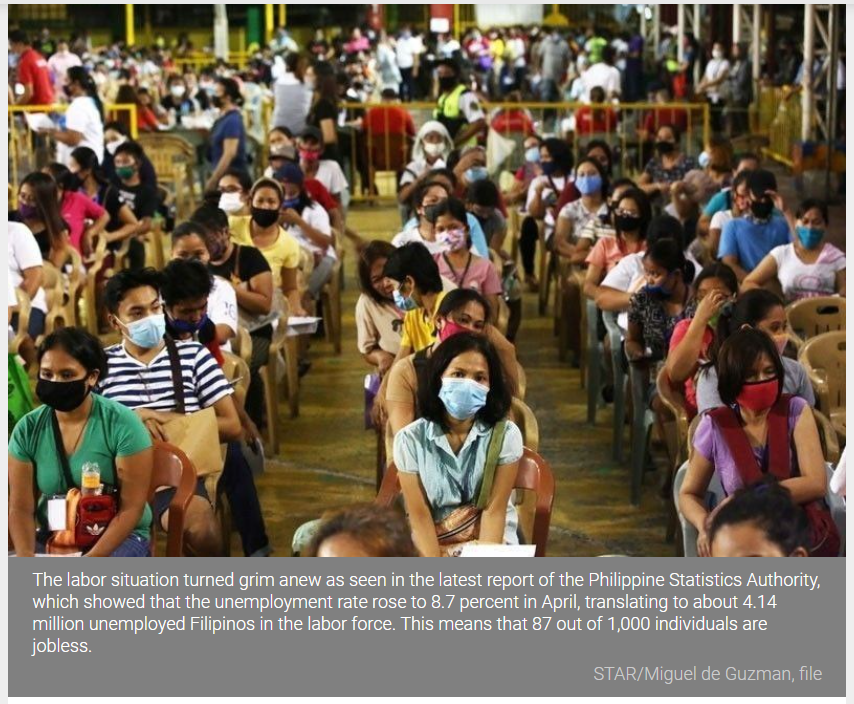Philippines: Lockdown pulls up jobless rate to 8.7%
MANILA, Philippines — The reimposition of strict quarantine measures wiped out the minimal gains in the country’s labor market as more Filipinos lost their jobs again in April.
The labor situation turned grim anew as seen in the latest report of the Philippine Statistics Authority (PSA), which showed that the unemployment rate rose to 8.7 percent in April, translating to about 4.14 million unemployed Filipinos in the labor force. This means that 87 out of 1,000 individuals are jobless.
This is a significant increase from the 7.1 percent jobless rate in March, which is equivalent to 3.44 million Filipinos who have no jobs.
However, the April 2021 rate still showed a large improvement from the record-high 17.6 percent unemployment rate registered in the same period last year when the lockdowns imposed were at their tightest.
Still, the latest employment figures show the impact of the renewed lockdowns in Metro Manila and nearby provinces amid a surge in COVID-19 cases.
In a joint statement, the country’s economic managers referred to the situation as a temporary reversal of gains, which show the tight link between labor market outcomes and the level of quarantine restrictions.
However, they said the overall labor market outcomes are still better than last year as the government took a more risk-based approach in imposing restrictions.
The National Capital Region recorded the highest unemployment rate at 14.4 percent, its second-highest ever after the 15.8 percent in July 2020. It was followed by CALABARZON with 13.4 percent.
The NCR Plus bubble (Bulacan, Cavite, Laguna and Rizal) had the strictest quarantine restrictions in April as it also saw the sharpest rise in COVID-19 cases.
Meanwhile, the underemployment rate, pertaining to the proportion of workers who were looking for more hours of work, also increased during the month.
Underemployment inched up 17.2 percent or 7.45 million Filipinos from 16.2 percent in March.
In fact, the underemployment rate in NCR rose sharply to 15.5 percent as more jobs shifted to part-time arrangements given capacity restrictions.
The country’s labor force participation rate or those Filipinos aged 15 years and above also decreased to 63.2 percent of the total working age population from 65 percent.
This is equivalent to around 47.41 million economically active Filipinos whether employed or looking for work.
Total employment rate also went down to 91.3 percent, translating to 43.27 million employed Filipinos. Overall, 2.1 million jobs were lost between March and April this year.
President Duterte’s economic team said the government is ready to take well-calibrated steps to achieve better health and job outcomes through further re-opening of the economy at the appropriate time.
This will be complemented by the expansion of the age group allowed to go out and gradually resuming face to face learning in the low-risk areas, all with the appropriate safeguards.
The government will also timely implement the recovery package and accelerate the vaccination program.
“With 27.7 million vaccine doses until July, we are confident that we can bring more Filipinos safely to work, inoculate 70 million Filipinos or the entire adult population by the end of the year, and recover strongly in the next two years,” the economic team said.
Meanwhile, the average weekly hours of work of an employed person also declined to 38 hours in April compared to 39.7 hours the previous month.
The industries that showed the largest drop in job creation include construction with 805,000 jobs, agriculture and forestry at 493,000, and wholesale and retail trade at 456,000.
Increases on the other hand, were recorded in education, accommodation and food service activities, and real estate activities.
Workers are grouped into the three sectors, namely, agriculture, industry and services sector. Those in the services sector comprised most of the employed persons accounting for 57.4 percent share during the period.
Services sector was followed by agriculture with 24.4 percent share while the industry sector accounted for the smallest share of 18.2 percent.
Source: https://www.philstar.com/business/2021/06/09/2104038/lockdown-pulls-jobless-rate-87


 English
English




